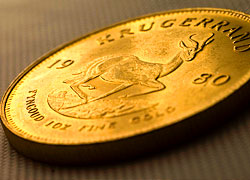
There are thirty-three known bullion coins in the world. Of these, 5 are made of platinum, 1 of palladium, 9 of silver, and 18 of gold. And of all these precious metal coins, the South African gold bullion coin Krugerrand is perhaps the most popular.
In 1967, the South African Mint Company introduced the Krugerrand, with the intention of circulating it as currency. Its status as a legal tender was seen as the best way for marketing South African gold around the world. In fact, thirteen years after its introduction, this precious metal coin accounted for about ninety percent of the gold coin market.
The Krugerrand comes in four varieties:
- One-tenth ounce coin (0.11 troy ounce in weight, 1.35 millimeters thick, and 16.55 millimeters in diameter).
- Quarter ounce coin (0.27 troy ounce in weight, 1.89 millimeters thick, and 22.06 millimeters in diameter).
- Half ounce coin (0.55 troy ounce in weight, 2.22 millimeters thick, and 27.07 millimeters in diameter).
- One ounce coin (1.09 troy ounces in weight, 2.84 millimeters thick, and 32.77 millimeters in diameter).
Each of these four coin varieties is 22K, containing 91.67% pure gold and 8.33% copper. This composition was meant to make the coins more durable and harder and thus resist dents and scratches, as, again, they were originally intended for circulation.
On the obverse of the Krugerrand is the face of Stephanus Jonannes Paulus Kruger, fifth president of the South African Republic (note the surname Kruger and the South African currency Rand were combined to give this precious metal coin its name). Also here are the Afrikaans and English versions of the name "South Africa", both inscribed in capital letters.
On the reverse of the coin is an image of the springbok, an antelope specie which is a South African national symbol. Atop the image is an inscription of the name of the coin, in capital letters, while below it is the coin's gold content, inscribed in Afrikaans and English.
Special samples of the coin (proof Krugerrand) are minted and offered as collector's items. These proof Krugerrands are priced above the bullion Krugerrands. The two coin versions can be distinguished from one another by the number of serrations they have - the proof version has 220, while the bullion has 40 less than the former's.
Other nations, such as Canada, Australia, the United States, and the United Kingdom, started producing their own precious metal coins one after the other beginning in 1979. The decisions of these gold-producing countries to mint their own bullion coins were most likely inspired by the success of the Krugerrand in its role as a vehicle for promoting the South African gold to the international market. As of 2008, about 1.3 million kilograms of South African gold, contained in Krugerrand coins, have been sold.
Unlike the bullion coin series of other countries, which come in gold and silver, the Krugerrand comes only in gold. Coins made of silver that are passed off as "Krugerrands" are neither produced by the South African Mint Company nor sanctioned by the government of South Africa.
No comments:
Post a Comment